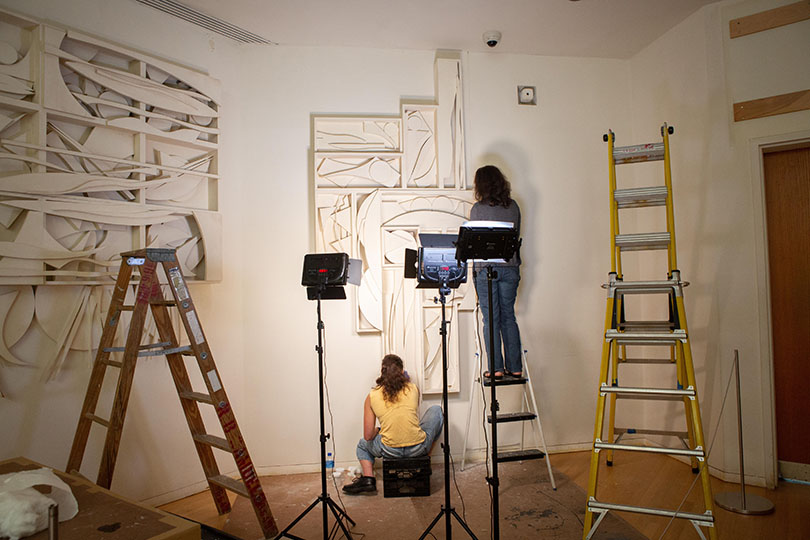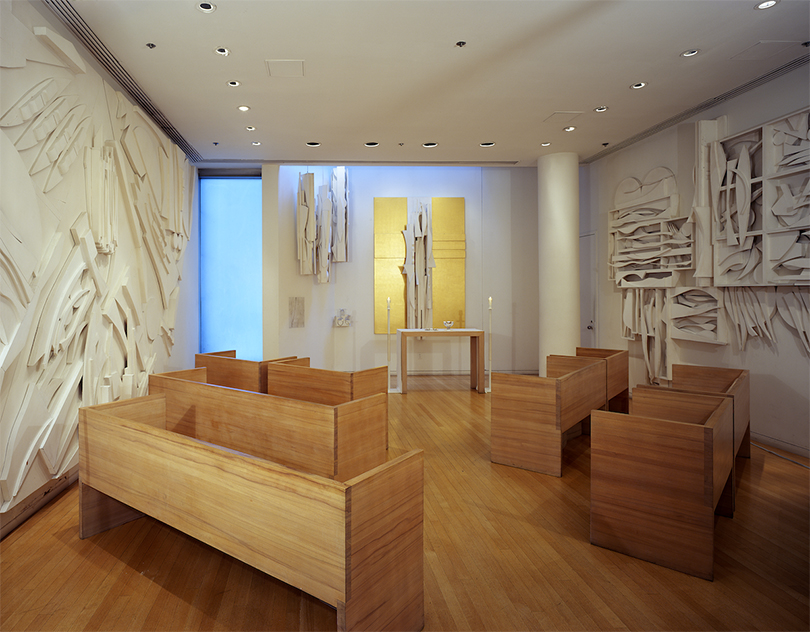By Clinton Krute

Behind every lasting artistic achievement is an intersection of practices—the sort of collaboration across disciplines that is central to the work of Pratt students, graduates, and faculty. Every artist, architect, and designer knows just how important it is to understand the chemical properties of paint, the physics of a curtain wall, or the science of mind and culture that underlie an aesthetic decision—and exploring how art and science intersect, and how to work in partnership with experts from other disciplines, is especially important for members of the Pratt community taking part in the care of historical artworks.
Over the past five years, Pratt chemistry professor Cindie Kehlet, conservator Sarah Nunberg—whose teaching at Pratt introduces topics that relate to conservation, such as materials degradation—and Pratt students, most recently Lauryl Sandman, BA History of Art and Design ’19, have worked on a project that has required partnership across a range of fields and practices, and among specialized practitioners and community leadership: the restoration of Louise Nevelson’s Chapel of the Good Shepherd, the artist’s immersive sculptural work at Saint Peter’s Church in Manhattan.
Nunberg, Kehlet, and Sandman have helped in the effort to painstakingly peel back the accumulated years from the 42-year-old Nevelson Chapel, as it is known today, to reveal and preserve Nevelson’s visionary installation, while Pratt alumna Jane Greenwood, BArch ’87, Principal of Kostow Greenwood Architects, has led renovations to the architecture of the space. Partnering with Saint Peter’s to conserve this major piece of American public art, Pratt community members have participated in a collaboration greater than the sum of its parts, linking art history and cutting-edge technology, technical precision and aesthetic resonance, an artist’s singular vision, and a space of refuge open to all.
Since its dedication in 1977, Nevelson Chapel has been a space of spiritual solace for many—open to the general public, located alongside the church structure at Lexington Avenue and 54th Street, where it is integral to Citigroup Center as a privately owned public art space. Nevelson envisioned the chapel as a “quiet place” in the heart of the bustling city; within it, her austere white sculptures—abstract assemblages of precise, custom cut-wood shapes—envelop visitors and evoke a sense of serenity. Nevelson designed the site as an anchor of sorts. She herself had come to the US as a child after fleeing the pogroms in Ukraine with her family.
They eventually settled in Rockland, Maine, where Nevelson spent her formative years before ultimately striking out for the melting pot of New York City. In a way, her work speaks both to the immigrant experience in the United States, as well as to the spiritual condition of all humans. Her sculptures—often constructed from found, discarded objects—reflect her own rootlessness while simultaneously conveying a sense of weight and groundedness, the sense that one might build a home from what others consider insignificant.
When Nevelson, whose family was Jewish, took on the chapel project in the mid-1970s, she expressed a more universal spiritual belief system, noting that she saw “no distinction between a church and a synagogue. If you go deep enough into any religion, you arrive at the same point of harmony.” Nevelson Chapel—its original design the result of a partnership between the artist and the architects of the soaring tower above it, built to house Citibank’s headquarters—has since been a place of reflection and quietude, a “point of harmony” between religions, people, and the often dissonant urban environment.
Over the decades since the chapel opened, the cut wood sculptures, covered with white alkyd paint, that Nevelson constructed to encompass the space have degraded badly. The humidity and temperature of the space fluctuated over the years and, making matters more difficult, the sculptural objects were repainted and touched up with a different type of paint several times since the 1980s. Sarah Nunberg, who in addition to her work in the Mathematics and Science Department at Pratt is principal of the Objects Conservation Studio, LLC, suggested a different approach when she began working on the project in 2012: Nunberg hoped to reveal the artist’s vision by removing the accumulated restoration paint and exposing the original paint. This would require “first researching the piece and understanding how Nevelson worked and how her other pieces had been treated,” Nunberg says. “Through those discussions, we began a multiphase project.”
As research proceeded, it became clear to Nunberg that she would need to develop a deeper understanding of the chemistry of the paint in order to identify “what the newer paint was, what the original paint was, and how they were interacting.” This is how Pratt’s Mathematics and Science Department became involved. Nunberg explained that she “ended up talking to a professor at Pratt, Cindie Kehlet, who studies the properties of art materials and their degradation.” Kehlet is now also one of the directors, along with Professor Eleonora del Federico, of the department’s newly opened Center for Research of Art and Design Materials, which houses the Licio Isolani Study Archive for which Nunberg is the conservator. “Starting in 2012, she came on to the project and we just worked together really well,” says Nunberg. “So we put together a class for two students of Cindie’s who were interested in this project. Then it just grew from there.”

Pratt student Lauryl Sandman, an art history major who joined the project last year, worked extensively with Nunberg and Kehlet on the investigative and hands-on work of restoration. In the process, Sandman learned the ins and outs of the conservation process, from the rigorous chemical analysis to the delicate, detailed manual practices involved. She discovered that the process is time-consuming, requiring conservators to very carefully remove the water-soluble PVA overpaint to reveal Nevelson’s original alkyd paint using a special cleaning gel created at and imported from the University of Florence.
As Sandman tells it, “over the summer, we did one sculpture, working full-time. They’re big sculptures that cover most of the walls, and that was one of the smaller ones. And it still took us the entire summer!” Sandman found the multidisciplinary work fascinating, and she’s excited to apply the wide range of skills she’s acquired in a career as a conservator, utilizing her knowledge base in chemistry and science as well as in the humanities. For Sandman, the skills she’s found most useful are flexibility and an openness to continual learning: “I’ve learned not only how to use this specific system, but also how much research goes into what we’re doing, and how much we’re constantly evolving treatment. It’s not one set thing we’re doing every day; it changes every time we learn new things about the objects.”
Nunberg stressed that the conservation work, central as it may be, is only one aspect of a complex effort to ensure that the chapel is preserved for the foreseeable future. Pratt alumna architect Jane Greenwood has been focused on restoring the environment itself, creating a space that will facilitate the preservation of the restored sculptures while staying true to the artist’s vision for the chapel. In addition to installing a dedicated HVAC and humidification system, this work also entails the construction of a new environmental and acoustical envelope and a new lighting system with smart technology. Greenwood, through her firm, Kostow Greenwood Architects, joined the project in 2017; she leads a team of engineers and lighting designers assembled by Saint Peter’s Church whose work aligns with the art conservation effort the church engaged Nunberg to carry out.
As an architect, Greenwood has worked extensively on sacred and public spaces, and notes that her firm’s role in Nevelson Chapel’s restoration has evolved considerably since beginning work: “We started out with a more limited mission, which was to bring the space up to a level that would, at the bare minimum, stop the decay of the art. But if you just address the humidity, you have to address the artificial lighting, and then the natural lighting. It just becomes a domino.” Greenwood credits her experience at Pratt as being crucial to her development as an architect and collaborator: “I had always wanted to work on urban projects: residential, commercial, preservation, restoration, and civic design. What better place to learn than New York City? Pratt fulfilled the desire I had to understand architecture from an urbanist perspective.”
Those lessons, in turn, prepared her for partnership, managing the many threads of the Nevelson Chapel project, from lighting design to environmental control to structural engineering, while maintaining perspective on the bigger picture of preservation of what is in its entirety a comprehensive historic space. For Greenwood, the restoration of Nevelson Chapel has special significance: “This is such a jewel of a project and reminds me of my mission and goals as a young architect—to contribute to the built environment in a positive way that enhances everyone’s experience. As architects in the public realm, we have a responsibility to create good design, and when we do, it’s amazing. It’s the best feel-good moment in the end.”
Greenwood and Nunberg highlighted the commitment and passion that Pastor Jared R. Stahler, who has served at Saint Peter’s Church since 2005, has brought to the project. For Stahler, as for the conservator, the chemist, and the architect, Nevelson Chapel is more than a religious space, more even than a work of art—it represents a determined spirit of community: “You go back and read [Nevelson’s] words, and she is saying, I’m not doing something for some narrow religious purpose, I’m doing this for the public, I’m doing this for humanity. She called it her ‘gift to the universe.’”
With members of the Pratt community marshaling their skills and knowledge to conserve this gift for the city, the art and environmental restoration of Nevelson Chapel is expected to be completed in December. An inaugural year of programming is planned to begin in January 2020.
Images (top to bottom): Sarah Nunberg (right) and Pratt student Lauryl Sandman treat overpainted wood surfaces with an innovative cleaning system developed in Florence, revealing Nevelson’s original paint for the first time in decades; credit: Leslie dela Vega/Nevelson Chapel. Nevelson Chapel view toward the altar; credit: @Thomas Magno Photography.